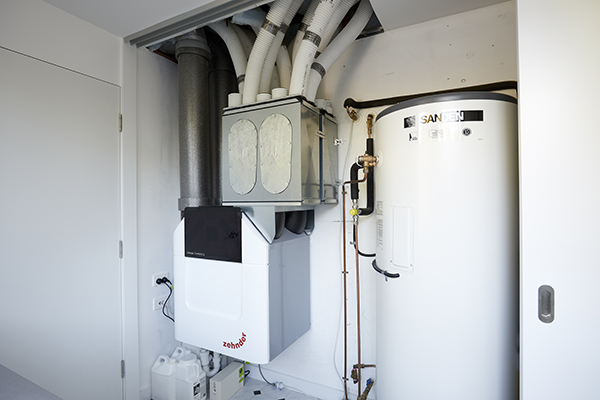Money-Saving Potential of HRV for Homeowners
The All-Inclusive Guide to the Uses of Heat Recovery Ventilation in Modern Structures
Heat Recovery Ventilation (HRV) systems stand for a significant advancement in constructing innovation (HRV Heat Recovery Ventilation). They provide an approach for exchanging stagnant indoor air with fresh exterior air while minimizing energy loss. This approach not just enhances interior air quality however also adds to power effectiveness in both residential and business buildings. Recognizing the various applications and advantages of HRV can disclose its essential duty in contemporary layout and sustainability efforts. The implications of this innovation deserve exploring even more
Comprehending Heat Recovery Ventilation Systems

Numerous modern structures prioritize power efficiency, recognizing warm healing ventilation (HRV) systems is crucial for enhancing indoor air quality and decreasing energy intake. HRV systems function by transferring warm from stale interior air to inbound fresh air, properly keeping comfy indoor temperatures while lessening power loss. These systems contain a warm exchanger, fans, and ductwork that facilitate the flow of air. Throughout winter months, HRV units catch and recycle warmth from the outbound air, while in summertime, they can assist cool down inbound air. By constantly trading air, HRV systems likewise minimize humidity and the concentration of interior contaminants. Appropriate setup and maintenance of HRV systems are crucial for their performance and performance in boosting total structure efficiency and comfort.
Benefits of Heat Recovery Ventilation
Heat recovery ventilation systems use many advantages that enhance both energy efficiency and interior air top quality in modern buildings. By catching and reusing power from exhaust air, these systems considerably lower cooling and heating prices, resulting in lower energy consumption. Additionally, they maintain a constant flow of fresh outside air, minimizing the risk of indoor air contaminants and allergens. This continuous exchange helps control humidity degrees, stopping mold development and ensuring a healthier living setting. Furthermore, HRV systems add to sustainability goals by decreasing overall carbon footprints. Their capability to optimize ventilation without giving up thermal comfort makes them an important enhancement to contemporary building layout, promoting both financial and environmental benefits.
Applications of HRV in Residential Buildings
As homeowners significantly prioritize energy efficiency and interior air quality, the applications of warm recovery ventilation (HRV) systems in household buildings have actually come to be much more widespread. HRV systems are especially beneficial in snugly sealed homes, where preserving fresh air flow is crucial for preventing moisture accumulation and indoor pollutants. They successfully transfer warm from outgoing stagnant air to inbound fresh air, lowering power expenses related to cooling and heating. Additionally, HRVs can enhance comfort levels by regulating humidity and temperature level. They are also adaptable for various property layouts, consisting of single-family homes and multi-unit structures. On the whole, incorporating HRV systems sustains lasting living practices while ensuring a healthier interior setting for residents.
HRV in Business and Commercial Setups
In business and industrial setups, the implementation of warm recuperation air flow (HRV) systems has actually become progressively crucial for optimizing power efficiency and preserving learn the facts here now air top quality. These systems successfully transfer warm from exhaust air to inbound fresh air, lowering the demand for extra heating or air conditioning. This not only lowers power prices however likewise contributes to sustainability efforts. Industries such as production, warehousing, and office complex profit substantially from HRV systems, as they assist control temperature and humidity levels, ensuring a comfy and effective setting. Additionally, HRV systems aid in getting rid of contaminants and excess moisture, enhancing interior air quality. As laws around air high quality become stricter, the adoption of HRV modern technology is most likely to grow, making it a crucial component of modern industrial and industrial framework.
Future Trends in Heat Recovery Ventilation Modern Technology

Regularly Asked Questions
How Does Heat Recovery Ventilation Effect Indoor Air High Quality?
Heat recovery ventilation substantially improves interior air quality by constantly exchanging stagnant indoor air with fresh exterior air while recuperating power. This process decreases pollutants, maintains optimal humidity levels, and ensures a healthier setting for owners.
Can HRV Solutions Be Set Up in Existing Buildings?
HRV systems can certainly be mounted in existing structures. Retrofitting might require modifications to ductwork and air flow formats, however it significantly improves power efficiency and interior air top quality, making it a viable option for older frameworks.
What Upkeep Is Required for HRV Systems?

Are There Specific Climates Where HRV Is Extra Effective?
Heat recovery ventilation systems are particularly reliable in climates with significant temperature level distinctions in between seasons. These systems enhance energy efficiency by recouping heat from exhaust air, making them suitable for both chilly and moderately warm atmospheres.
How Do HRV Equipments Affect Energy Expenses?
